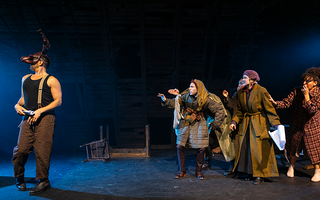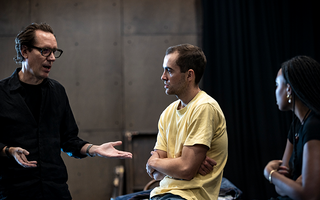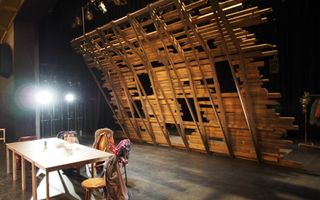 On Stage
On Stage
Associate Director of A Midsummer Night's Dream, Jules Billington, reflects on the Elements of Theatre Composition in the 2024 production. As outlined in the Study Design for VCE Theatre Studies, the elements of theatre composition can be used to give structure to the interpretation or the way it is presented on stage in performance to an audience.
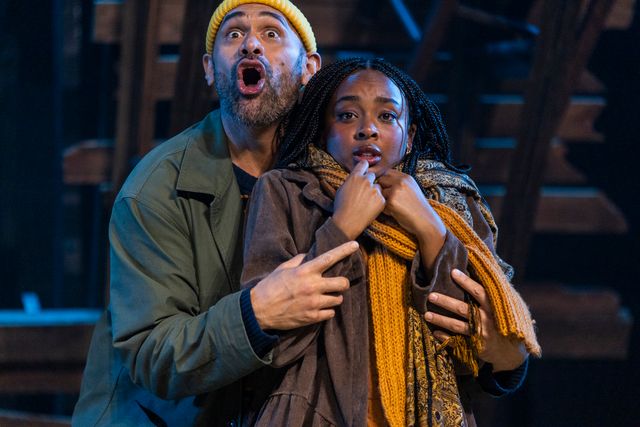
Matu Ngaropo as Bottom and Ahunim Abebe as Snug in A MIDSUMMER NIGHT'S DREAM(2024)
COHESION
The unity and balance of various aspects of the interpretation.
The choice of Bell Shakespeare’s A Midsummer Night’s Dream to begin with the Mechanicals scene first demonstrates cohesion of the structure of the show. We start the performance looking through Puck’s eyes watching The Mechanicals arrive and cast their play, and we end the show with Puck commenting on the nature of performance itself after watching The Mechanicals’ Play within A Play. This bookending of the show is satisfying, using cohesion to tie the show together.
There is also cohesion demonstrated in the costume design. Although there are three different worlds in A Midsummer Night’s Dream, within each world there is a cohesive feel and palette. The Mechanicals wear layered, practical, earthy colours, indicative of Puck’s “hempen-homespuns” descriptor. The Lovers are gowned in fashionable, luxe, higher status garments all with tones of rich jewels such as sapphire, gold, and ruby. The Fairies are unified and clothed in black, depicting them as “shadows” with flowing coats that evoke the feel of wings, creating dramatic, mystical silhouettes.
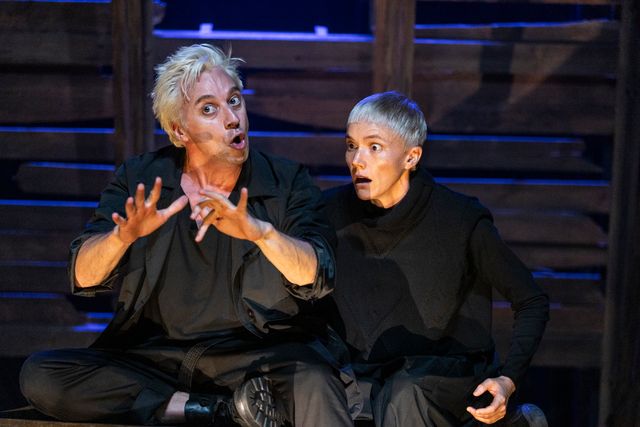
Richard Pyros as Oberon and Ella Prince as Puck in A MIDSUMMER NIGHT'S DREAM (2024)
MOTION
The movement or implied movement of actors and design features in the theatre space. This may include position, pattern, arrangement, proportion and spatial flow.
Every aspect of the Fairies in A Midsummer Night’s Dream implies motion and movement. Entrances and exits are done in a flurry, using motion to imply supernatural abilities and vast distances covered in un-human speed. The costume design too conjures motion in the long coats, especially as actors pounce through the set portals, with their costumes swiftly gliding behind. Even in their performative style the fairy attendants rarely stay still, constantly shifting their centres as well as their visual focus, reminiscent of curious and alert forest animals.
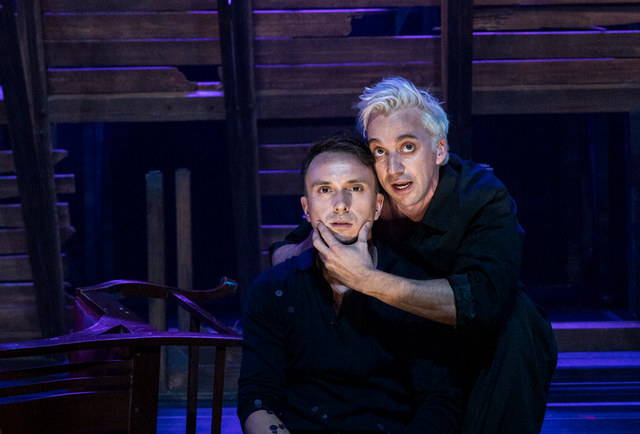
Mike Howlett as Demetrius and Richard Pyros as Oberon in A MIDSUMMER NIGHT'S DREAM (2024)
RHYTHM
The pace, timing and tempo within the interpretation.
Rhythm is a key tool for storytelling in A Midsummer Night’s Dream, most noticeably used in freeze frames and slow-motion when the Fairies wish to pause, control, manipulate or comment upon the mortals. Oberon freezes the Lovers while investigating them, and Puck puts the Mechanicals into slow motion while they rehearse their play in the forest before freezing them entirely to cause further mischief. In both of these instances, the use of rhythm helps place our focus on the story telling moment we need to see, before allowing the ensuing eruption of chaos to then overwhelm us.
The rhythmic language for the fairies is so strong that, by the time we are in the second half of the show, it becomes the only fairy signifier we need. When Titania and Bottom call attendant fairies to them, the four actors playing the sleeping Lovers a scene ago, rise up in the smooth fairy rhythm we have become accustomed to; we don’t need a costume change to depict that the actors have shifted from being The Lovers into Fairies, the rhythm and movement quality tell us. The Rhythmic choice for the Fairies here also aids the overall rhythm of the show by removing the need for clunky costume changes and instead relying on the performative skill of the actors.

Isabel Burton as Starveling (as Moon) in A MIDSUMMER NIGHT'S DREAM (2024)
EMPHASIS
Aspects of the interpretation are given a particular focus, importance or prominence.
The final scene for the show, the Play within a Play, uses lighting to highlight its stand-alone prominence. The rest of the show is lit from overhead, the front and the side to illuminate forests, courts, interiors and exteriors. However, The Play within a Play employs only 1940’s style footlights. It gives a rudimentary, low-fi feel to the scene, emphasising the conceit that these actors are amateurs.
Emphasis is also used in the final moments of the show, as Puck places the post-performance celebrating Mechanicals into slow motion, while Puck speaks in real time directly to us. The meta-theatre of this moment is highlighted by Puck being fully and clearly lit, while the actors are in darker, lower lighting behind. This stage picture helps to emphasise that watching theatre – due it its impermanence – is like a memory or ‘dream’ as Puck calls it.
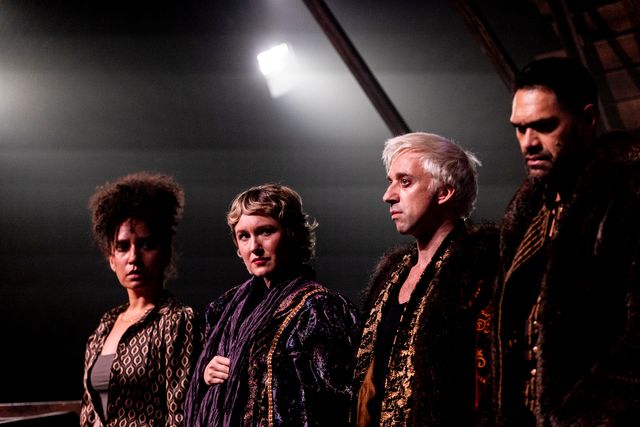
Isabel Burton (Helena), Imogen Sage (Hippolyta), Richard Pyros (Theseus) and Matu Ngaropo (Egeus) in A MIDSUMMER NIGHT'S DREAM (2024)
CONTRAST
Juxtaposition of seemingly different or opposing aspects or qualities within the interpretation.
Perhaps the largest use of contrast in A Midsummer Night’s Dream is how the world of The Court is depicted compared to the chaos of the forest. Straight lines of tables lined up end to end with performances directed mostly out, are juxtaposed against the messy chaos of the forest with tables upturned, dangling chairs and rubbish scattered across the floor. When the Lovers are awoken at the end of the play by Theseus, the stage structure shifts from messy, disheveled, coupling lovers back into the straight, rigid, and ordered lines of the court, even though we are still in the forest location. You may like to think about what this implies about the nature of the Court and its rules, and how they attempt to impose upon the chaos of the natural world.
Negroponte’s set design is also clever in how it responds to light to create contrast. The semi porous back wall seems solid when lit only from the front, yet when lit from behind, it suddenly opens up the space to appear permeable and infinite in how far it reaches.
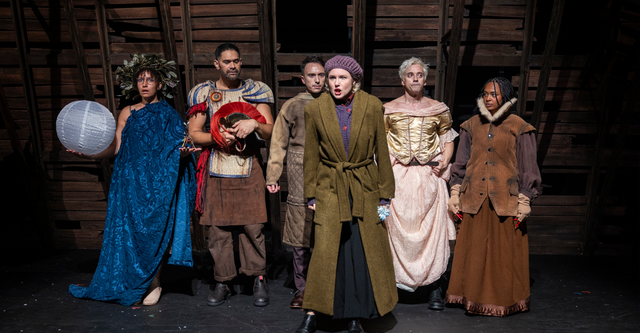
The Mechanicals present their play in A MIDSUMMER NIGHT'S DREAM (2024)
VARIATION
Changes to the dynamics of the interpretation, as may be evident in the use of tension, conflict, intensity, energy and use of the space.
Variation can be seen in the performative choices from the actors when playing the Mechanicals in the “Play within the Play”. These previously boisterous, bravado feigning, seemingly knowledgeable amateur actors are suddenly thrust in front of an ‘audience’, and we see them encounter nerves and stage fright. The previously self-assured Bottom panics when he realises he’s forgotten his sword, Peter Quince who has words for all occasions stumbles over lines. The variation from their prior scenes is what creates the comedy, as we watch them all endearingly bumble their way through the wide-eyed terror of performing.
